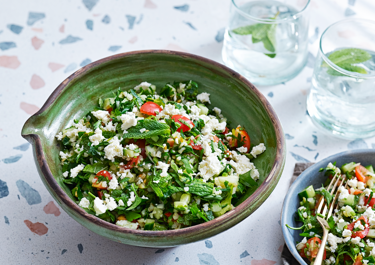Tabbouleh

Tabbouleh is a wonderfully tasty salad with lots of parsley and mint. It's perfect for serving with everything from lamb steak and chicken to salmon and falafel. Tabbouleh is an obvious choice for meze. Prepare your tabbouleh a few hours before serving to allow the flavours to settle.
Ingredients
|
Bulgur
|
40 g |
|---|---|
|
Leaf parsley
|
100 g |
|
Fresh mint
|
2 bunch |
|
Cherry tomatoes
|
250 g |
|
Cucumber
|
1 |
|
Shallots
|
2 |
|
Fresh green chilli
|
1 |
|
Lemons (unwaxed), finely grated zest and juice
|
2 |
|
Olive oil
|
3 tbsp |
|
Salt
|
1 tsp |
Instructions
Tabbouleh
How do you keep tabbouleh from getting soggy?
When making tabbouleh, it’s important not to cook or soak the bulgur in too much water. The grains should be dry to the touch before going in the salad. Other sources of liquid can be the parsley and the vegetables. Make sure to dry the parsley after rinsing it, preferably in a salad spinner. By lightly salting the vegetables in a colander, you can extract some of the water and get more concentrated veggie flavours in the tabbouleh.
Why is my tabbouleh bitter?
The most likely sources of bitterness in a tabbouleh are parsley and olive oil. The parsley should be finely chopped to avoid bitter flavours. As for the olive oil, use a good-quality, extra virgin oil. Taste a few drops of the oil before using it in the salad, to ensure that it will go well with the other ingredients and add deep, peppery goodness without too much bitterness.
How are you supposed to eat tabbouleh?
You can serve tabbouleh as a side dish with meat, fish, or vegetable main dishes. It’s also a natural part of any meze spread. Here, the tabbouleh can be served in a big sharing bowl, with each guest scooping the salad into a smaller bowl or plate and eating with a spoon or fork alongside the other meze dishes.
How long does homemade tabbouleh last in the fridge?
Leftover tabbouleh should be stored in the fridge for up to four days. Place the salad in a container with an airtight lid or cover the bowl with cling film to keep it fresh and protected from unwanted aromas. Don’t be surprised if you find that the flavours in your tabbouleh have melded and deepened overnight, making it even more delicious.
Tabbouleh: perfect as a fresh side salad or meze dish
Tabbouleh is a truly versatile salad with fresh, green flavours that go well with a wide range of main dishes. With roots in Lebanese cuisine, tabbouleh is a given whenever it’s time to enjoy meze, small middle-eastern dishes and finger foods.
A must for the perfect meze
If you’re planning a meze spread for friends and family, don’t forget the tabbouleh. This herby Lebanese salad brings bright and fresh flavours to the table, with bulgur to help turn the small meze dishes and finger foods into a delicious meal.
How to make tabbouleh without bulgur
Looking for an alternative to bulgur grains in your tabbouleh? Try quinoa, as this grain will add texture to your salad. It’s also possible to simply leave out grains altogether. The remaining leaves and vegetables will have all the bright and fresh flavours, but without the texture of the grains.
Try these different variations
The easiest way to vary your tabbouleh is to play around with the amounts in the salad to match your preference or mood. For example, you can easily add more bulgur and vegetables. You can also adjust the flavours in the salad, by swapping the mint for basil or other herbs. Another way to boost your tabbouleh’s flavours is to make a vinaigrette with garlic and perhaps Dijon mustard to drizzle over the salad before serving.








